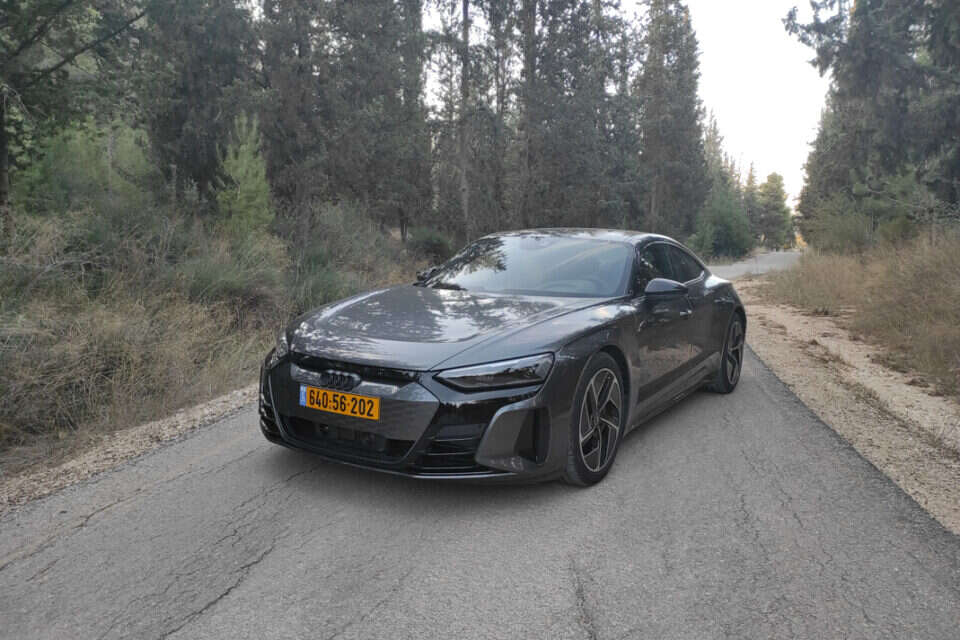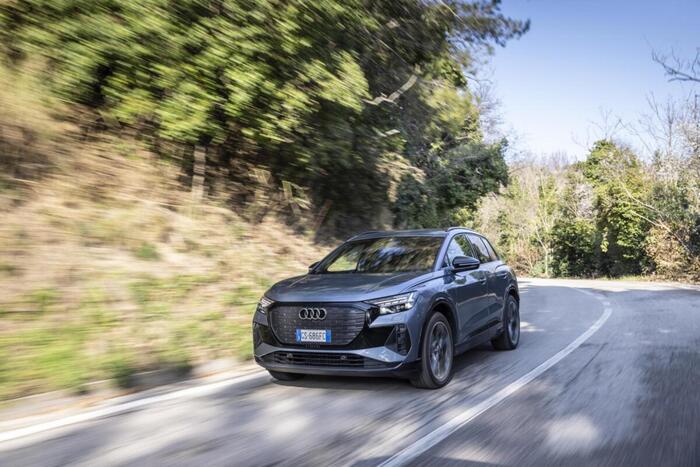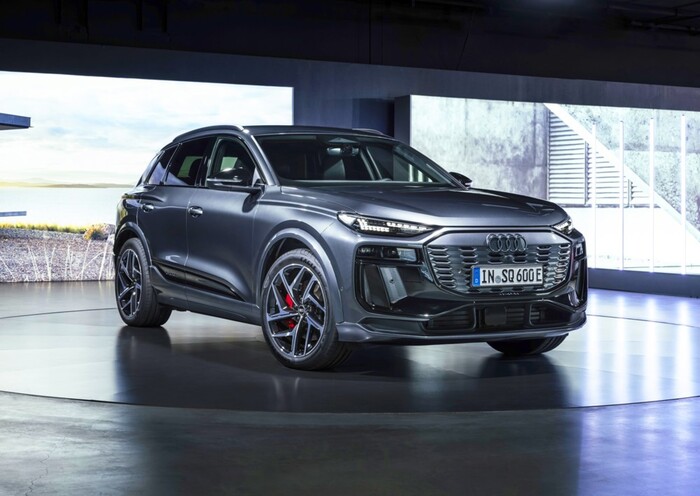Every car manufacturer has its own flagship model, the one that shows the company's current capabilities as well as its future direction.
Usually the same model will introduce the new design language of the manufacturer and the new technologies that will come later to the other models as well.
More from Overdrive >>>
In the case of Audi if they do a survey on the street where people will ask who they think the leading model is we will most likely get 2 options in the form of the sporty Audi R8 or the luxury A8.
But this is no longer the correct answer.
Not because these are cars that do not deserve to lead a brand, on the contrary.
Simply because there is someone new in the city who represents Udi's slogan "progress through technology" today.
The saying that has accompanied the German brand for 51 years (January 71), a full decade before the famous Udi Quattro of the 80s that is considered by many to be the manufacturer's first flagship model.
It was followed by a number of other models that held the flag such as: Audi RS2, Audi A8, Audi TT and of course also the first generation of Audi R8.
Now it's the turn of the Audi e-tron GT introduced in early 2021 to get the baton from the e-tron leisure-space models that held it before it.
It is impossible to ignore the fact that in the near future the automotive world is going in the direction of electricity.
A look at the amount of electric models that have arrived in the country in the last two years only reinforces this, and Udi was among the first in the country to market electric vehicles intended for the general public.
Those that are not niche vehicles or have an unusual design, but vehicles that at first glance will be difficult to identify that are not driven by an internal combustion engine.
So true, this non-tron is not exactly a vehicle for the general public with a price tag of NIS 765,000 before additions.
She also does not look like another vehicle on the road, given the amount of looks she drew and the amount of people who approached to ask about her throughout the test.
It starts right from the headlights.
Since the first generation of the R8 Audi has been a pioneer in lighting development in the automotive world, and has always known how to create a unique design for its headlights both front and rear.
So it is very easy to detect even at night that it is an Audi vehicle approaching us or moving away from us.
In the case of the non-throne, already at the opening of the car remotely, you can see (preferably in the dark) the dance of the headlights turn on gradually one after the other, turn off for a split second and turn on again at once.
If we wanted drama and excitement, Udi tries to create it even before we even get to the car.
Just like its name, Audi defines it as a GT vehicle that is an acronym for Grand Tourismo.
A category that has existed since the beginning of the 20th century, characterized by vehicles that combine luxury with dynamic capabilities, ones that can take the occupants of the vehicle and cross Europe lengthwise or widthwise by combining speed and comfort together.
Vehicles in this category will usually look large, wide and low whether they are designed for a couple of people or whether they also have a seat in the back seat.
One look scans the non-throne and reveals proportions and design that hit exactly the target.
With a length of 499 cm and a width of 196 cm it is as large as an executive car and with a roof height of only 141 cm (1.7 cm less than the A7) it is closer in height to sports cars than family cars.
Stopping refueling, sorry loading, fast on Route 6 allows you to check this in depth.
The Etron transmits speed even before it moves from its parking space.
With a large and dominant grille in the front from which a low front trunk lid (electric remember?) To the windshield is drawn.
The roofline sloping backwards early and looking as if it had eaten all the space intended for the heads of the passengers in the back seat and meets a high trunk line adorned with a backlight strip from end to end in keeping with the current trend in various sports vehicles.
Wherever you look it is simply beautiful.
The charging itself did not take long thanks to the use of the vehicle's electrical system that supports 800 volts.
We started with a 33% battery and within 24 minutes it was already at 85% which allow a range of 331 km according to the trip computer.
With a fully charged battery, with a capacity of 93 kWh, the Audi declares 487 km, but in practice the range that the car itself presented was 421 km if you choose a saving mode from the various driving modes. It's also the recommended driving mode most of the time, probably compared to the comfort mode which felt almost exactly the same as the economy mode except for increased power consumption and a slightly shorter driving range. The car came with the air suspension which was great with excellent damping of the road both on the maps within the city and on bumps and waves on the highway. He provides them all with one soft and pleasant rack movement without passing it to the occupants of the vehicle.
According to Udi itself, the I-Tron is the Grand Tourismo vehicle of the future.
The seats are supportive and comfortable with a low seating position and wide separation between the front seats.
In the back there is barely enough space for an older couple thanks to a floor socket for the legs that allows the seat to be installed low and thus allow for good headroom.
The front trunk is small with 85 liters and the rear is wide and deep but slightly flat because of the upgraded and excellent audio system in the test vehicle (of Bang & Olfsen) so the cabin volume has been reduced to 366 liters instead of 405 without the same system.
In addition there is a huge sunroof on the roof of the car with no closing option that blocked the pleasant heat of the sun on pleasant test days but may be less pleasant in the summer months.
Unlike the exterior muffs, the cabin itself felt a little less different and special.
The atmosphere and cabin design feels similar to the cabins of other company models.
Of course there is a lot of screen technology and armature here.
But the design language chooses Udi's familiar line and does not try to produce a completely different experience.
On the ride it turns out that the noise isolation is excellent, especially when we remember that there are no engine noises and all the other noises are more noticeable to our ear.
Only a slight noise from the tires was heard and at high cruising speeds a slight wind noise was recorded.
But none of them demanded that we raise our voices to have a conversation.
The same noise isolation also takes time to digest the pace at which the Etron is capable of devouring driving roads.
The lack of noise from the engine may catch a vigorous driver coming at a significantly higher speed above the possible limitations in rotation.
Because despite the high curb weight (2,350 kg) the Audi manages to feel significantly lighter, thanks to the low center of gravity of the complex batteries in the car floor.
The brakes are strong with a good bite and even Pirelli's green tires manage to cope with hiding the massive mass.
The non-tron feels safe with a slight tendency to widen the line with gas exaggerations on the one hand, but can be playful in acute and proactive weight transfer. Even without switching to sporty driving mode it is possible to produce a very fast driving pace. If we touched on the more sporty mode, then the weight of the steering wheel stiffens and with it the suspension, and still offer great restraint to the chassis without looking for a dentist nearby. The pedals behind the wheel of internal combustion vehicles are responsible for lowering and raising gears and are responsible for increasing / decreasing regenerative braking. Unfortunately even in the most aggressive mode they simulated light engine braking in a manual vehicle. Too bad, feels you can work with them in a more noticeable way.
The term quattro goes hand in hand with Audi, which has always been characterized by its dual propulsion system and the i-Tron also gets propulsion for all wheels from a pair of engines, one per axle. With a power of 469 hp and 64.3 kg, power is not lacking at any stage. The unresponsive engine and throttle pedal calibration feel that each of its displacements directly adds the required percentage of power. We measured the classic acceleration to 100 km / h in 4.2 seconds, a tenth of the manufacturer's statement, but more impressive was the intermediate acceleration between 80-120 km / h which took 2.49 short seconds - detours have never felt so short and easy.
Another point to note was that the power consumption also in the dynamic part of the test consumed 48% of the battery in which we drove a fairly aggressive 114 km.
This is a figure quite far from Audi's official range figure it may sound like a lot but if you compare sports cars with petrol engines, they have a significantly higher fuel consumption gap between a leisurely cruise and dynamic driving.
This is 30.3 kWh per 100 km in aggressive driving compared to 18, but it must be borne in mind that cars of this type simply drag the driver to repeatedly stick their foot to the end.
Accelerations have power and there is a price.
Of course a more relaxed and sensible ride will significantly increase the range.
But on the other hand, whoever buys a car with such capability, it is better for him to use it.
In total on the test days we achieved an average range of 328 km.
This includes traffic jams, fast cruising and dynamic driving segments.
Restraint is not our strong suit…
According to Audi, the Etron GT is strong, sporty, confident and exciting.
This is the approach according to which Udi develops and builds its vehicles.
She also notes that the target audience of the new model is sports car enthusiasts who are interested in sustainability, design and technology.
According to the company, the target audience consists of educated people with a sufficiently high income to own several vehicles at the same time.
What is important to note is the fact that the Etron is heavily based on the Porsche Taken (even the tires have a dedicated Taken code).
Except for exterior design, cabin and slightly different calibration for vehicle suspensions are identical sisters.
Audi has a more harmonious and beautiful design while Porsche has a much more special cabin and fits the price tag they carry.
The big advantage of the Audi is in the price tag, which is NIS 120,000 lower than its German sister, before they start marking the options that exist in the list of additions.
So the question arises can a brand's flagship car be another car in a change of cloak ?!
And does such a situation really illustrate the slogan "progress through technology"?
Because on the one hand there is no doubt that this is a very impressive car.
But it is mostly impressive below the (beautiful) surface where most of the development belongs to Porsche at all.
So the biggest competition for this car comes from home and it is called Takeken.
Beyond this matter, and back to the daily use of traffic jams, city and a leisurely cruise on the highway you can drive without fear 400 km on a full charge.
In them the audio will feel comfortable, pleasant and isolated from the environment.
Alongside these, this is a car that allows the driver who wants more, to push it and find out what lies beyond the next round.
The technology in it, will take care of pushing the skilled driver and that less, forward.
Audi e-tron GT
electric engine
Power: 469 hp
Torque: 64.3 kg
Chalk: Direct, single transmission ratio
Motivation: Dual
Wheelbase: 290 cm
Weight: 2,350 kg
Acceleration from 0 to 100 km / h: 4.1 h
Maximum speed: 245 km / h
Driving range (test): 328 km
Price (base): NIS 765,000
Pros: Attractive
Cons: Restraint
Bottom line: fast and impressive electric touring
Were we wrong?
Fixed!
If you found an error in the article, we'll be happy for you to share it with us






/cloudfront-eu-central-1.images.arcpublishing.com/prisa/2C5HI6YHNFHDLJSBNWHOIAS2AE.jpeg)



